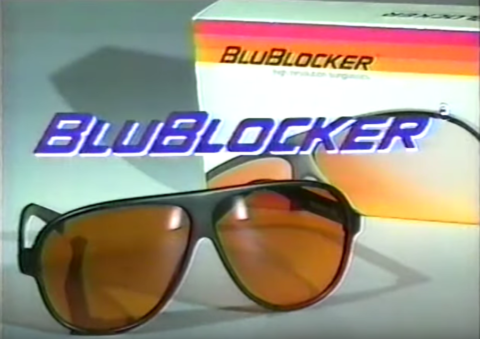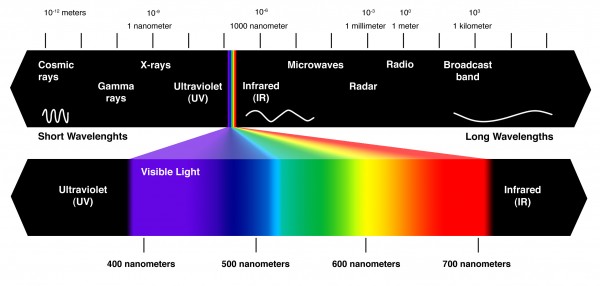
Today’s “blue light blocking” glasses may be more stylish but the intent is the same as the infamous 90’s infomercial.
Like a lot of people, I’ve been spending a lot more time staring at a computer screen lately. I have been working from home since March, and what used to be face-to-face meetings are now Zoom/Teams/GoToMeeting video calls. With videoconferences and related work, I’m easily spending several more hours per week staring at a computer screen. Afternoon headaches became a common occurrence shortly after this started, which I attributed to screen time and poor ergonomics. School for both of my kids has been transformed to an online environment too, with even more hours per day (above the baseline) spent staring at electronic devices. Recently my daughter told me she was also getting headaches, and she needed “blue light blocking glasses” which would apparently help. (The source of this medical advice was probably TikTok.) I spent some time searching for evidence on blue light exposure, and what I found was a sizeable industry that blames “blue light” for all types of illnesses and holds up special glasses as the panacea. The marketing push for special glasses appears to have accelerated over the past few months given the surge in shelter-at-home orders and the increased reliance on video calls and remote work/education.
Why blue light?
If you search long enough you’ll find blue light from electronic devices is blamed for most modern ailments. Overexposure (however that is defined) is said to increase your risk of cancer, obesity, heart disease, diabetes and retinal damage. And that risk is said to be elevated because of our obsession with staring at electronic screens, large and small.
Our eyes can see only a narrow spectrum of light. Visible light ranges from violet/blue light (around 400nm) through red light (around 700nm). Incandescent lights have a spectrum similar to that of the sun. Low-energy light sources, like fluorescent lights and light-emitting diodes (LEDs) do not. Electronics are often cited as causing increased exposure to blue light, owing to LEDs that have a blue peak in terms of output. While the output may not be high, we stare at these devices for hours per day, increasing the concern that we are being exposed to “unnatural” light that may be harmful.
Our biggest source of blue light, even today, is sunlight. This exposure is arguably beneficial, as it has an important role is establishing our circadian rhythms, which guide our sleep-wake schedule. Blue light can boost attention and perhaps even mood. We all probably get much less blue light exposure than our ancestors of just a few generations ago, with 90% of American lives now spent indoors.

The evidence
There is no published evidence to demonstrate that normal environmental (including electronic) exposure to blue light damages eyesight. However it is acknowledged that eye strain can occur from staring at electronics, which can cause fatigue and headaches. Regular breaks from staring at screens (large or small) is recommended to reduce eye strain.
There is some evidence that blue light from electronics can disrupt circadian rhythms, however, by suppressing the production of melatonin, a hormone that regulates our sleep. This has led electronic manufacturers to offer “night light” settings that reduce the amount of blue light displayed and give your screen’s display a pinkish “warm” tone. In this setting, amber or “blue light” blocking glasses can work like a “night light” setting for our eyes, blocking the blue-light disruption that can be caused by artificial lights or electronic use. But there is no evidence to show that the blue light from electronic devices causes harm. Nor should it, as it’s well below the levels our eyes are exposed to when we’re outside. An analysis published in Nature examined exposure from a number of electronic sources and compared it to international limits. It noted:
Humans have evolved under natural light from the sun. Intentional staring at the sun causes eye injuries, as is reported after solar eclipses.6, 7 However, continuous viewing of the blue sky, certainly in the UK, does not present a risk of eye injuries. Comparing natural exposures with the reasonably foreseeable exposure to optical radiation from lamps, computer screens and mobile devices, such as smartphones shows that the actual spectrally weighted irradiance is lower than the natural exposures.
The panacea: Blue light blocking glasses
Sales of blue light blocking lenses are surging from $18 million USD in 2019 and are expected to reach $27 million USD by 2024. Optical chains are among the biggest proponents of special glasses. Last year the television show CBC Marketplace sent hidden cameras into major eyeglass vendors and found opticians promoting blue-light blocking glasses (or coatings on prescription glasses) as a way of protecting yourself against fatigue, retinal damage and even cancer. In the United Kingdom, Boots Opticians was fined £40,000 in 2017 for making misleading claims about the effects of blue light and the benefits of their “Boots Protect Plus Blue (BPPB) lenses”:
In a decision published today (26 May), the optical regulator found that there was potential for patients to be misled by the multiple overstating claims about blue light and the benefits of its BPPB lenses in an advertisement that was published in The Times in January 2015.
The Advertising Standards Authority (ASA) received complaints about the content of the advertisement, including claims that blue light from LED TVs, smartphones and energy saving light bulbs caused damage to retinal cells over time, and that BPPB lenses protected against blue light from these sources. The authority found that these claims were misleading and unsubstantiated.
Blue light glasses can be purchased anywhere. The extent to which they actually block blue light can vary, with some models showing a heavy yellow/amber tint, and others without any tint. There are many testimonials from happy users, but none of the vendors I found online could offer any credible evidence to back up their claims. My daughter ordered a pair off AliExpress for $2.00, but you can spend hundreds.
There is very little published research on the effectiveness of blue light blocking glasses. A 2017 systematic review examined the benefits and harms on visual performance, macular health, and the sleep-wake cycle. It concluded:
We find a lack of high quality evidence to support using BB spectacle lenses for the general population to improve visual performance or sleep quality, alleviate eye fatigue or conserve macular health.
Other relevant or more recent research I could find included:
- A small study of ten radiology residents (who stare at screens for a living) randomized to blue-light blocking glasses or sham glasses, with endpoints being reported measures of occupational fatigue. Wearers of the blue-light blocking glasses reported fewer symptoms. All I could find was the abstract, which recommends additional studies with larger sample sizes.
- Another study looked at amber lenses vs. “placebo lenses” worn two hours before bedtime, and their effects on insomnia. It found the amber lenses effectively reduced insomnia.
- One study that looked at the effect of reducing blue light in smartphones at night. This was not a study of blue light glasses, but of the “night mode” setting in our phones. It found that blue light in the evening, delivered via smartphone, negatively affected sleep patterns.
What we can draw from this is that claims that blue-blocking glasses have vast health benefits are not substantiated by robust evidence. There is some evidence for reducing blue-light exposure before bedtime because of effects on sleep.
What do eye experts recommend?
The American Academy of Ophthalmology says that there is no evidence that the kind or amount of light coming from electronic devices is harmful or damaging to the eyes, and does not recommend special eyewear for electronic use. It makes the following recommendations to minimize eye strain:
- Sit about 25 inches (arm’s length) from the computer screen. Position the screen so you are gazing slightly downward.
- Reduce screen glare by using a matte screen filter if needed.
- Take regular breaks using the “20-20-20” rule: every 20 minutes, shift your eyes to look at an object at least 20 feet away for at least 20 seconds.
- When your eyes feel dry, use artificial tears to refresh them.
- Adjust your room lighting and try increasing the contrast on your screen to reduce eye strain.
- If you wear contact lenses, give your eyes a break by wearing your glasses.
The Royal Australian and New Zealand College of Ophthalmologists also notes that there is no evidence behind claims that blue light from electronics is harmful, or that blue light filtering eyeglasses are necessary or beneficial. A 2019 position statement notes:
A review of current literature has concluded there is little evidence with respect to using blue light blocking spectacles to improve visual performance (19). In addition, there are no studies showing such filters can conserve macular health. It should also be noted that avoiding all blue light may have unwanted effects as there is some weak evidence that blue light is useful in the daytime to improve concentration and mood (20).
They also note:
There may be a benefit to reducing screen time in the evening or using night-time settings on screens in the few hours before bedtime to reduce interruption to circadian rhythms. General measures to reduce symptoms of eyestrain include taking regular breaks and focussing on distance objects from time to time as well as ensuring spectacles, if worn, are appropriate for the task. It is recommended to consult a health care professional if symptoms of eyestrain persist.
In the United Kingdom, the College of Optometrists completed a systematic literature review on the issue, and says the following:
The best scientific evidence currently available does not support the use of blue-blocking spectacle lenses in the general population to improve visual performance, alleviate the symptoms of eye fatigue or visual discomfort, improve sleep quality or conserve macula health.
So what about all this eyestrain?
While blue light glasses won’t protect your eyes from harm, there is probably some merit in minimizing blue light exposure a few hours before we plan to sleep. The eyestrain we’re all feeling is more appropriately addressed, not with blue light glasses, but with the simple hygiene measures recommended by experts. Blue light glasses are not harmful, but there is no solid evidence that they will effectively reduce eye strain or fatigue more effectively than paying attention to, and addressing, eye strain. Limiting evening exposure to blue light delivered via electronics and smartphones is probably a more effective strategy than counting on eyeglasses to mitigate those potentially negative sleep effects. As for me, as work from home continues for the foreseeable future, I’m taking more breaks from my computer during the day and trying to get outside for a few minutes every hour. Speaking of which…

